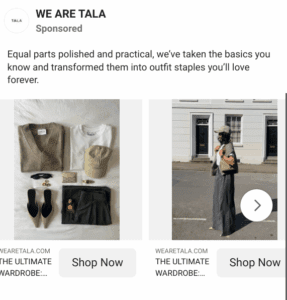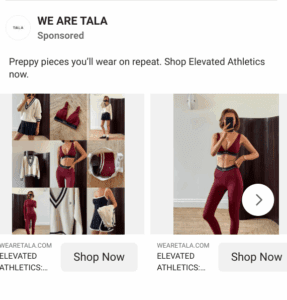
The data behind the performance of carousel ads

In social marketing, it’s important to stay constantly updated with elements such as ad formats and know which format works best on which platform. Are single images the way forward? Is video content the winner? Or are carousels the winning format? We’ve taken a deep dive into carousel ads, including key stats to know, how carousel ads work on all major platforms, and some examples of how to utilise carousel ads effectively.
So, what are carousel ads? Essentially, they are a series of single images that are intended to be viewed together. They can be utilised in a number of different ways, including:
- Showing different elements of a product
- Showing multiple products
- Telling a story in sequential order, either through images or a combination of images/graphics/text
Although the basic format of carousels stays the same across all social platforms, each platform has different definitions of a carousel ad, different ad objectives for carousel ads, and different best practices for them as well.
We’ve broken down how carousel ads work on each platform, but before we jump ahead, here are some key stats you need to know about them:
- The average engagement rate per post for Instagram carousels is 1.92%, higher than the average engagement rate of 1.74% for images and 1.45% for videos.
- Instagram carousels have the highest engagement rate but only account for 19% of Instagram content.
- Using all 10 slides in a carousel post, Instagram users can expect their engagement rate to surpass 2%.
- Telling followers to swipe left and continue exploring the carousel can increase your engagement rate from 1.83% to 2%. However, this strategy is underutilised, as only 5% of carousels contain the “swipe left” slide.
- According to a 2024 report found that carousels were the type of post with the highest engagement rates for both the alcohol and higher education industries.
TikTok
Now we know the stats, let’s take a closer look at carousels on different platforms, including what they’re used for and best practices. We’ll start with TikTok:
According to TikToK: ‘Carousel format is an image-based creative format, allowing advertisers to upload 2-35 images in the sequence. Users can swipe between different images to view more details and control the viewing pace by themselves.’
There are multiple carousel formats available to use on TikTok, which include:
- Standard Carousel: Available for Traffic, Web conversion, Lead generation, app promotion, and Reach (Auction) objectives.
- Video Shopping Ads (VSA) Carousel: Available for Product Sales objective. Leverage your catalogue images as TikTok-in-feed ads (for TikTok placement) and Interstitial Ads / Rewarded Ads / APP Open Ads (for Automatic placement and Pangle only placement). Users can swipe across the multiple SKU images displayed in order. According to TikTok, there are multiple purposes and reasons to utilise carousel ads on the platform, including:
- Showcase multiple products or services: Users can view multiple products or services by swiping across a single Carousel Ad. Each image on the Carousel can feature a different item and give users a broader view of what your business offers.
- Tell a Deeper Story: Carousel Ads provide you with the opportunity to showcase a single product with the ability to share more in-depth product information. The opportunity to share additional information can create a more engaging narrative that enriches the audience’s knowledge of a specific product.
- Test and learn: Carousel Ads allow you to experiment and observe which elements resonate most with the audience. You can measure the click-through rate (CTR) on each image to gain insights into the effectiveness of different images and headlines.
Now let’s take a look at how carousel ads can help you achieve success on LinkedIn. According to LinkedIn, these are the main benefits of carousel ads on the platform:
- Share with more space: Showcase your brand’s message over multiple images, immersing your audience with each swipe.
- Accelerate consideration with professionals: Get in front of decision-makers with eye-catching visuals that invite interaction.
- Measure impact for every engagement: See how many professionals engage with your cards and optimise for results.
They also say: ‘Carousel ads on LinkedIn allow you to tell an interactive story to inspire your target audience to take action.’
Here’s some information from LinkedIn on metrics that align with common carousel ad goals:
- Brand awareness and consideration: impressions, clicks, engagement rates
- Website visits: click-through rates
- Demand generation: conversion rates, leads, and cost per conversion
Different objectives require different considerations, and it’s important to carefully consider what your objective is before deciding what you want to feature in your carousel. Here’s what LinkedIn recommends:
For brand awareness and brand consideration:
- Tell your brand story
- Provide insights to position yourself as a thought leader
- Share stories of customer success
For conversions:
- Showcase multiple products or services
- Feature a single product or service in depth
- Highlight various opportunities, like events or helpful resources
Some best practices LinkedIn recommends when running carousel ads on the platform are:
• Capture and maintain your audience’s attention with visual storytelling.
• Feature graphics, people, and dynamic text to draw your audience in.
• Include clear messages and calls-to-action on each carousel card description.
• Leverage existing content by packaging together content with a similar theme, or deconstruct a large piece of content into carousel cards.
• Start with 3-5 cards in your carousel, and test adding more cards from there.
• Try slotting your carousel cards in different orders, and optimize based on performance.
• If you tell a story, place the main value add or call-to-action in the final card to encourage your audience to swipe through the whole carousel.
LinkedIn recommends that to make the most of the carousel ad format on the platform, you
‘Refer to LinkedIn carousel ad specs while planning to make sure that your content is formatted properly.’
Meta
Next, we’ll focus on Meta– this is a huge platform with a lot of opportunity for advertisers to get their message out there to highly relevant audiences, and carousel ads can be very beneficial in doing so. Here’s what Meta has to say about carousel ads on their platform:
‘The carousel ad format is available for Facebook, Instagram, Messenger, and Audience Network, and allows you to showcase up to ten images or videos within a single ad, each with its own link. With more creative space within an ad, you can highlight different products, showcase specific details about one product, service, or promotion, or tell a story about your brand that develops across each carousel card.’
As with the other channels, there are multiple reasons to incorporate carousel ads into your strategy on Meta. Some of the main reasons Meta has highlighted are:
- If you want to show off multiple products, feature a different product on each card that links to its own landing page. Give customers more options and help raise your click-through rate.
- If you want to highlight the features of a single product, use each carousel card to show different product angles or details to better inform customers.
- If you want people to actively engage, tell a compelling story that develops across cards – the interactive format encourages people to swipe through for more.
- If you want to explain a process, give people a step-by-step tour of how your business or product works.
Examples
One brand that utilises carousel ads in a particularly effective way is TALA. TALA is an activewear brand with many different products that sit within many different collections. Showing these off to people in an effective way without losing their attention is a tricky task, but TALA has nailed it with their well-thought-out carousels. In the example below, you can see a carousel to advertise TALA’s basics collection. The carousel is effective because it utilises different styles of imagery in different settings (flatlay inside and someone actually wearing the items of clothing outside). The mixture of curated and authentic UGC content allows the user to see the items of clothing in different scenarios. The carousel also includes the person wearing the items of clothing doing different poses, and the camera shots are varied to show the clothing up close and also from a distance. Just through the images, the user gets a very detailed idea of what the clothing looks like from different angles, how it sits on a real person, and what it looks like up close. This makes a carousel more valuable in this instance than a single image, as it delivers more information to the audience. The carefully thought-out sequence of images is also accompanied by well-written copy that tells the audience what they’re looking at.

Another good example of a carousel by TALA shows off their ‘Elevated Athletics’ collection. Again, this utilises different creative imagery by combining a collage-style image with UGC images. It also includes multiple items from the collection. Had a single image ad been used instead, it would have been very difficult to show off multiple items within the collection, and the audience would not have been able to see and appreciate each one individually. This is a great example of the right time to use a carousel ad over other ad formats.

Learn More
As you can see, there are many reasons to include carousel ads in your Paid Social strategy across all platforms. They can help you tell stories, share product details, explain processes, and show off your product range. They help to increase engagement and ultimately offer more to your audience than a single image can. When designed correctly and combined with the right ad copy, carousels can be a highly effective way to achieve results at every part of the marketing funnel.
The Paid Social team at Embryo are experts when it comes to Paid Social strategy. They are constantly keeping up to date with the latest industry updates and changes to all platforms, including updates around AI, in-platform features, and ad formats. They know the platforms inside and out, and can help take your Social strategy to the next level through their in-depth knowledge of ad formats, creative, and messaging. You can read more of their work here:
- Paid Social basics explained- Our Senior Paid Social Manager, Jenny, has broken down everything you need to know about Paid Social, including ad formats, how to optimise your paid social campaigns, outlining objectives and how to incorporate influencers into your Paid Social strategy.
- Paid Social Data and Where to Find It- Our Head of Paid Social, Harriet, shared her knowledge on Paid Social data, including platform data and Google Analytics
- A/B testing best practices to optimise your paid ads– Our Senior Paid Social Executive, Emma, shared her expertise in testing on Paid Social, including how to set up A/B testing, and A/B testing best practices.
At Embryo, we also have experts in other areas of marketing who regularly share their in-depth knowledge on their personal areas of expertise. We believe it’s important to take a multi-channel approach to marketing and know each channel inside and out. Channels work hand in hand and can help each other succeed. For example, having an effective Paid Social strategy can help drive brand awareness and search volume, which can then help PPC. That’s why our experts from each team regularly share their expertise. You can read some of their blogs here:
- 15,049 Statistics about Digital Marketing (SEO, PPC, Social Media)– Our Chief Innovation Officer, James, shared this huge list of stats that span across SEO, PPC and Social, to help you better understand each channel and how they work together.
- ROI In Social Media and PPC: When Should You Expect Peak Returns?- Our Senior Account Director, Steven, explores the differences in Paid Social and PPC in this blog, and how you can expect to see your Return on Investment differ on both.
Still need some help with your Paid Social strategy? Our experts are here to help. Contact us today.
The sources for this blog are here:
- https://www.rivaliq.com/blog/instagram-carousel/#:~:text=While their photo posts only,engagement rate of photo posts.
- https://publer.com/blog/instagram-+carousel-stats/
- https://ads.tiktok.com/help/article/carousel-ads?lang=en
- https://business.linkedin.com/marketing-solutions/cx/21/10/carousel-ads?mcid=6920802863245840391&src=go-pa&trk=sem-ga_campid.16914679831_asid.138385873609_crid.593140786929_kw.carousel
- https://www.facebook.com/business/ads/carousel-ad-format


